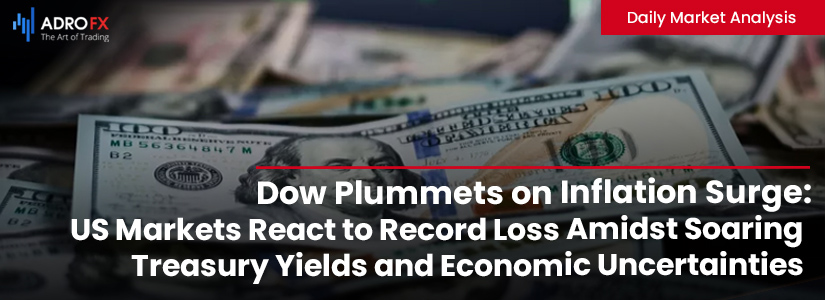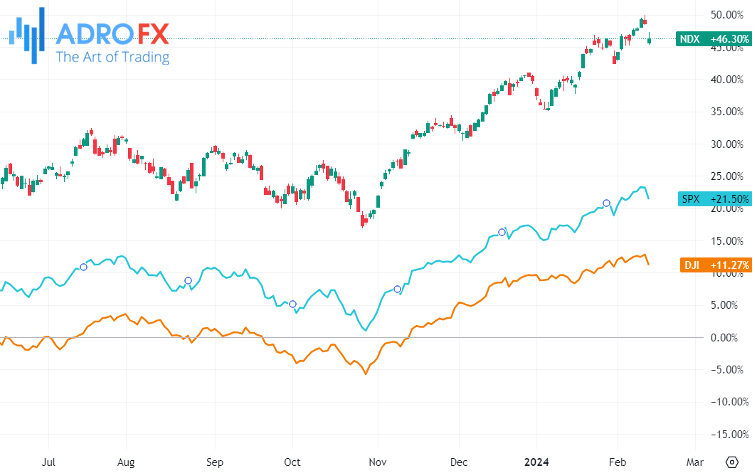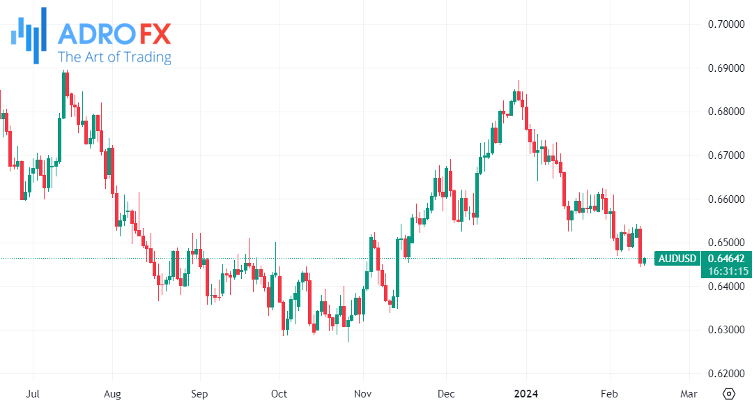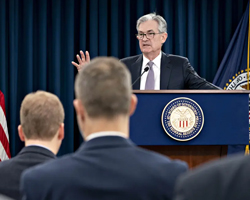Dow Plummets on Inflation Surge: US Markets React to Record Loss Amidst Soaring Treasury Yields and Economic Uncertainties | Daily Market Analysis

Key events:
- UK - CPI (YoY) (Jan)
- USA - Crude Oil Inventories
- Japan - GDP (QoQ) (Q4)
On Tuesday, the Dow experienced a substantial decline, marking its most significant daily loss since March 2023. This downturn was triggered by a surge in Treasury yields, propelled by an inflation report that exceeded expectations. The report dampened hopes for an earlier and more aggressive Federal Reserve rate-cutting cycle.
The S&P 500 witnessed a loss of 68.14 points, equivalent to 1.37%, concluding at 4,953.70 points. Simultaneously, the Nasdaq Composite saw a dip of 282.64 points, representing a 1.79% decrease, settling at 15,659.91. The Dow Jones Industrial Average experienced a substantial fall of 522.05 points, translating to a 1.36% decrease, closing at 38,275.33.

The headline annual US inflation exhibited a slowdown to a 3.1% pace in January, down from 3.4% the previous month, although it surpassed economists' estimates of 2.9%. Core inflation, closely monitored by the Fed as it excludes volatile elements like food and fuel, maintained its annual pace at 3.9%, consistent with December figures but expected to decelerate to a 3.7% pace.
Treasury yields recorded significant increases, with the 2-year Treasury yield surging by 18 basis points to 4.654%, and the 10-year Treasury yield jumping by 14 basis points to 4.315%.
The inflation report's heightened figures were attributed to the "lumpy shelter/rent component," according to RBC. The broader indications of a reacceleration in inflation pressures, coupled with a robust labor market, reinforce concerns that the Federal Reserve may not need or be able to pivot to interest rate cuts as swiftly or aggressively as previously anticipated.
During the Asian session on Wednesday, the Japanese Yen exhibited positive momentum, rebounding from a two-month low against the US Dollar recorded the previous day. The yen's resilience was influenced by verbal intervention from Japanese authorities as weakness above the psychological mark of 150.00 prompted their response.

Additionally, a generally subdued tone in equity markets contributed to the yen's safe-haven appeal, fueled by expectations of an impending shift in the Bank of Japan's policy stance. The USD/JPY pair faced downward pressure from a modest decline in the US Dollar.
However, the prevailing belief that the Federal Reserve will maintain higher interest rates for an extended period, buoyed by a resilient US economy and persistent inflation, acted as a tailwind for the Greenback. The reduced expectations for aggressive policy easing by the Fed supported elevated US Treasury bond yields, potentially limiting further appreciation of the JPY and allowing for the prospect of dip-buying around the USD/JPY pair. Caution is advised before positioning for deeper intraday losses.
The Australian Dollar attempted to recover from recent losses during the Asian session, following a decline driven by robust US inflation data for January. The AUD/USD pair faced downward pressure as the S&P/ASX 200 Index experienced a significant drop, reaching its lowest levels in three weeks due to a sell-off in mining and financial stocks influenced by Wall Street's reaction to stronger-than-expected US inflation figures.

The EUR/USD pair hovered around 1.0710 in the Asian session on Wednesday, maintaining its position after reaching three-month lows. The Euro found relief from better-than-expected Economic Sentiment data from the Eurozone and Germany. Investors awaited preliminary Gross Domestic Product data and a speech by Christine Lagarde, the President of the European Central Bank, scheduled for Thursday.

Speculation grew regarding potential interest rate cuts by the ECB in the second quarter, but comments from ECB Executive Board member Piero Cipollone suggested that there might not be a necessity for further constraints on demand to tackle inflation, indicating a potential halt in raising interest rates.

The impact of inflation data weighed on gold, which had held strong above $2,000 this year. However, under the pressure of higher rates, the precious metal finally declined. The future trajectory for gold will hinge on the severity of the data, creating a "good news is bad news" scenario ahead of retail sales data. The idealized scenario of a robust economy, low inflation, and rate cuts now appears challenging.









